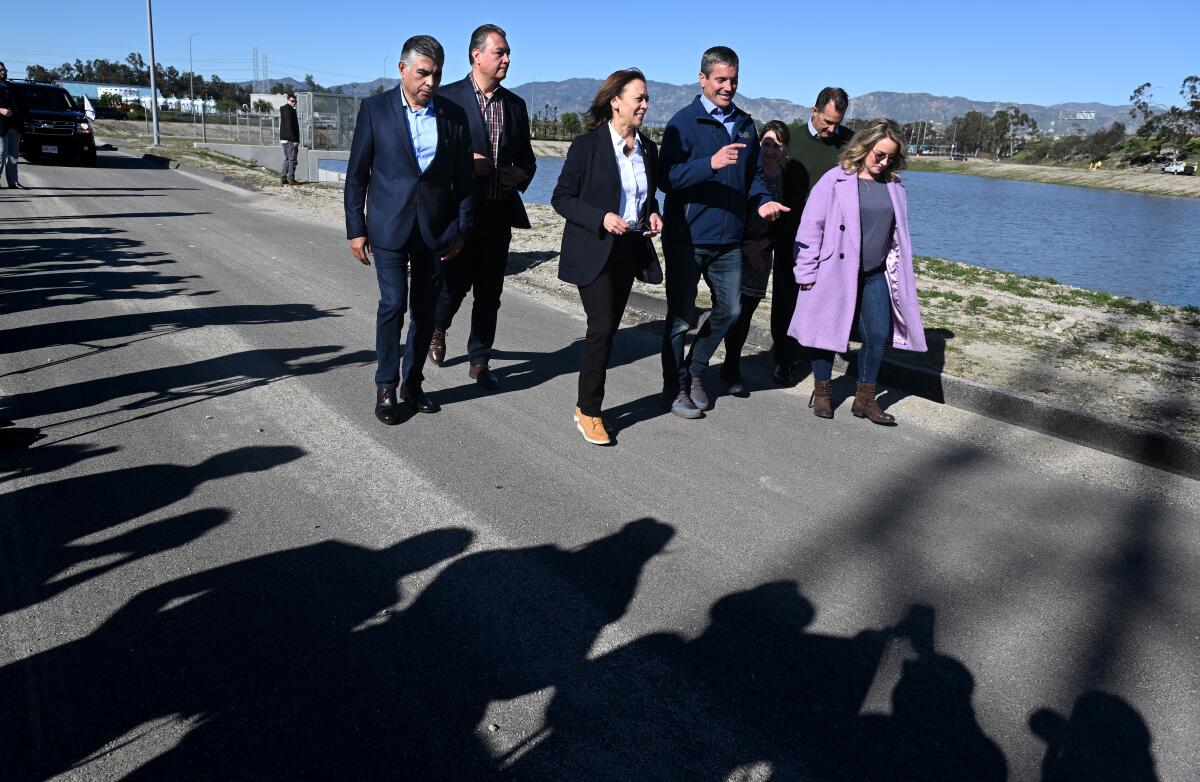Kamala Harris visits L.A. stormwater project in wake of record-setting rains

- Share via
Vice President Kamala Harris on Friday joined state and local leaders at a Los Angeles County site recently upgraded to increase groundwater retention, where they touted ongoing efforts to improve drought resiliency across California and neighboring states.
Harris’ visit came on the heels of a series of storms that battered the state for weeks, causing fatalities, flooding and extensive damage — but also provided record-setting precipitation needed in the water-starved West.
Harris said the climate whiplash — from years of severe drought to pummeling rain — was indicative of the climate crisis, requiring better preparation for such weather extremes. And with much of that recent stormwater already flowing into the Pacific, the situation has renewed calls to change how the state collects and stores rainwater.
“It requires us to be present and to be in front of ... variations of extreme weather that produces a lot of water and extreme weather that produces drought,” Harris said Friday, making her latest appearance in her home state. She has returned often to California during her tenure as vice president, choosing various cities as sites to make White House policy announcements, rally for state issues and support local initiatives.
President Biden, joined by Gov. Gavin Newsom and U.S. Sen. Alex Padilla, tours areas along the California coast damaged by storms.
She spoke from the banks of a newly upgraded facility in Los Angeles County’s Sun Valley known as the Tujunga Spreading Grounds, which aims to increase the amount of rainwater and runoff captured in massive earthen bowls, which then is used to recharge groundwater. There are more than two dozen spreading grounds or basins in Los Angeles County.
“I’m happy to be here to highlight the work that is happening in this facility and in California as an example of what can and should be happening throughout our country and around the world,” Harris said.
She pointed to the $12 billion in federal funds from the Bipartisan Infrastructure Law and Inflation Reduction Act allocated for projects across the West aimed at improving drought resiliency.
“We can build up resilience and adaptation,” she said, “and do the kind of work that is happening right here, which is investing in smart ways to store water so that we will have that water in times of crisis.”
Harris has repeatedly advocated for water-focused projects, especially in and around her home state.
The vice president was joined at the spreading grounds by U.S. Sen. Alex Padilla (D-Calif.); Rep. Tony Cárdenas (D-Pacoima); Tanya Trujillo, the Interior Department’s assistant secretary for water and science; California Natural Resources Secretary Wade Crowfoot; and other local and state environmental leaders.
Crowfoot thanked Harris and President Biden for their continued support during the winter storms and moving forward through recovery.
“Their leadership, their commitment have meant that we’ve been able to respond to these emergencies more quickly, preposition personnel and assets,” Crowfoot said. “On a personal note, the vice president’s experience as a Californian brings so much to these challenges that we face, whether it’s flood or wildfire or drought.”
Harris’ trip comes the day after Biden visited California’s Central Coast, assessing some of the worst damage from the storms and promising continued federal support for the state’s recovery efforts. Damages could reach $1 billion. Across the state, the storms that began Dec. 26 and lasted into mid-January caused major flooding, mass power outages and more than 500 mudslides, and led to at least 22 deaths.
The president’s visit followed weeks of support for California from federal agencies, including the Federal Emergency Management Agency, after he issued an emergency declaration for the state. Biden reiterated promises of federal aid issued through a separate major disaster declaration in the counties of Monterey, San Luis Obispo, Santa Barbara, Merced, Sacramento, San Joaquin and Santa Cruz.
The Times is tracking the latest national opinion polls on the favorability of Vice President Kamala Harris.
Although Southern California fared better in the storms than the northern and central regions of the state, it experienced significant rainfall, which brought flooding, mudslides and at least one massive sinkhole, and prompted multiple rescues.
But the storms also improved drought conditions across the state — with many areas seeing record rainfall — though experts warn California is far from ending its years-long drought.
The majority of the state remains in moderate drought, and 40% is still considered to be in severe drought, according to the U.S. Drought Monitor.
The state has spent billions in the last few years on water supply projects, such as the Tujunga Spreading Grounds, which have focused on increasing groundwater recharge, stormwater capture and reservoir storage. Gov. Gavin Newsom this week said he has proposed $202 million for flood protection and $125 million for drought-related actions for next year’s budget.
“California isn’t waiting to act — we’re moving aggressively to modernize how we capture and store water to future-proof our state against more extreme cycles of wet and dry,” Newsom said in a statement. “We’re expediting projects across the state to maximize stormwater capture and storage above and below ground during times like these, reshaping our water systems for the 21st century and beyond.”
Crowfoot said these types of projects would be a focus this spring, including finding new ways to capture the unusually high snowmelt that came with the storms.
“I’m optimistic in large part because of the leadership of the Biden-Harris administration,” Crowfoot said. “We have more funding to build infrastructure that we need to build to adapt to this weather whiplash than we have had in a generation.”
Staff writers Hayley Smith and Taryn Luna contributed to this report.
More to Read
Sign up for Essential California
The most important California stories and recommendations in your inbox every morning.
You may occasionally receive promotional content from the Los Angeles Times.














